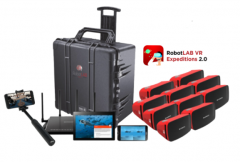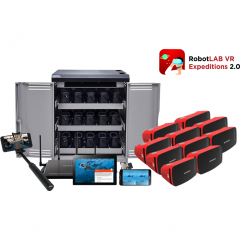Though it often takes a backseat to virtual reality, augmented reality tools are equally impressive. Even for education, AR (as it's commonly known) helps instructors create unique and fruitful learning experiences. It is a versatile tool that offers teachers so many different avenues for engaging any students and it's viable in almost any academic subject. Plus, students might already be familiar with some of its applications without even realizing it. So, let's explore some prime examples of augmented reality in education and how it could positively affect both teachers and students.
A Background on Augmented Reality
To fully understand the uses and benefits of augmented reality, it can be helpful to start with some basics. You can think of AR as having two distinct foundational elements: the real world and computer generated enhancements. Typically, using AR involves placing a device over a physical object or landscape. An AR-enabled device can recognize existing physical objects and then generate virtual enhancements over that reality. Some of these enhancements might also contain important information, messages, and additional context. And, usually, these messages are super eye-catching since the user sees them displayed over a view of the real world.
How does AR work?
AR content takes the form of 3D shapes or models on a mobile device. For most AR experiences, even in education, the simplest way to access this technology is using a smartphone. Essentially, students need a device to use it but don't necessarily need any bulky system, which is the case with some more prominent VR tools for education. They could use AR with or without headsets and often easily pair it with tablets or smartphones. Students can even use it with PCs when it comes to some select augmented reality tools. As for displays, different AR devices allow users to experience and interact with content differently. There may be 2D images or 3D images, which offer a more immersive experience of the entire world around them.
How augmented reality is created (the basics).
To create augmented experiences, your device's camera needs something to scan. Before somebody uses an AR tool, somebody else will have needed to scan tons of different objects that then all come together to make up a database of shapes. At that point, the device's camera can detect those objects and generate a digital, on-screen replication that will then appear over that one particular object. In order to create each of these necessary images, it typically involves a fairly in-depth process. It's been around for a few years now, though, so it doesn't take as long as it once did. And, this allows AR systems to expand and become more efficient over time—as people continue to use this technology without even realizing it.
Using AR in the Classroom
There are many different ways teachers and students can use AR in the classroom. For example, teachers can use this content to supplement instruction or as the entire basis of it. They can also use it in just about any academic subject. AR allows students to truly interact with some of the topics they're discussing while offering new points of view and getting them thinking about events in fresh ways. In fact, some teachers do argue that augmented reality enables children to interact with the world in a newly enhanced and optimized manner. In an academic setting, AR can change a student's perception of what they're looking at as well as their perspective—whether it's a brand-new science or an ancient environment.
Which subjects are good for augmented reality?
Simply put, some AR systems are more on the complex side. This is because, in order for them to provide the most in-depth experiences, they require advanced computing power and graphics. All smartphone AR solutions, however, still offer a worthwhile experience that's more affordable and practical. Because of this, the uses of AR in the classroom are truly plentiful. For starters, medical students can use it to visualize the steps in a surgery just as elementary students can use them for something as simple as exploring a unique ecosystem. As for subject areas, it's most useful in science subjects as well as the humanities and arts. AR tools could help make these lessons more interactive and, as time goes on, teachers may begin using it for more specialized areas of instruction on a regular basis.
Designing a classroom for augmented reality use.
Of course, teaching with AR is much more effective in in-person learning. To be honest, it would take lots of strategizing to use it in a remote or hybrid situation. In their classrooms, however, teachers should first focus on how they'll use AR to advance specific learning goals. We know that AR is a great supplemental tool, for example, as opposed to the only medium students use to absorb content. Essentially, this means that teachers might want to utilize traditional instructional methods and then draw on AR to help reinforce key points or concepts. Finally, teachers should make sure that students are somewhat familiar with using this type of technology (this can happen through practice). If they could progress through lessons without slowing things down, AR makes a great teaching tool in many classrooms.
Benefits of Augmented Reality in Education
You may have figured out that, since we're talking about it, augmented reality can provide some noticeable improvements to student learning outcomes. What, specifically, will play into that equation, though? At the core of it, AR can increase student engagement levels and create interactive experiences for students with different preferred learning styles. And, the nature of the AR content is often the top reason why. Typically, educators speak about the immersive experiences they can create for students when using virtual reality in the classroom. Immersion is a powerful element across education these days and it's actually a similar comparison for AR as it helps pique student interests and gets them thinking about things in new ways.
The most common benefits of augmented reality.
Besides that, AR almost intrinsically helps enhance some important learning abilities that students need for today's world. For example, it could help them activate certain problem-solving, collaboration, and creation skills that can, without a doubt, serve kids well. Also, many common benefits of AR in education are similar to VR but AR systems are often more affordable, making cost one of those added advantages. Like VR, AR can also inspire empathy in students. Whether it's through collaborative learning experiences or by gaining a more in-depth perspective on an issue by seeing it from a new point of view (literally), augmented reality apps can certainly help.
Specific skills students gain when using AR.
Believe it or not, there isn't necessarily this huge learning curve when it comes to AR tools. Many students can pick it up quickly, which allows them to spend more time using it to actually deepen their knowledge of curricular content as opposed to learning how to navigate this technology. Also, when it comes to inspiring empathy, this can happen largely because of its 2D nature. Combining an added dimension with activating student emotions can truly help kids establish empathy and also enhance their memory skills. All in all, AR helps kids build reading, numerical, play, creation, and scenario-based skills when integrated effectively.

Improving Learning Outcomes with AR
When it comes to AR in education, students are not the only ones who can experience benefits. In fact, some prospective educators have really ramped up using VR devices to simulate classroom experiences while in college programs over the last few years. And, when you think about it, teachers at all levels of K-12 education could potentially do the same with AR. If it's a tool they can teach with, many times, it's also a tool that they can learn with. This means that educators have some more options when it comes to their PD these days. Whether they use AR as an instructional resource or as a personal PD resource, the simple technology has already proven its value for 21st century educators and tech integrators.
Augmented reality and CTE.
Augmented reality tools can even help create new courses and instructional content areas, specifically for high school students. Specifically, CTE teachers can use AR tools to offer beginner level career training for students with interests in different industries. Watching someone carry out typical job responsibilities while they're immersed in the actual work environment can be invaluable for students in CTE programs. Beyond that, AR is already impacting a lot of consumer industries, like entertainment and shopping. And, exposing students to the role this technology plays can also have an effect on their future career goals.
How augmented reality can help students.
As for children, we know that AR can improve learning outcomes if implemented purposefully. One way it can help is by allowing teachers to repurpose and reinvigorate older instructional resources, like books. If compatible, augmented reality can add new dimensions to these resources (literally) and ultimately better engage students. Additionally, students can typically access AR materials from anywhere, including while they're home if they have a device. It also helps teachers explain complex subjects more clearly, provides an alternative visual for students, helps them focus their attention on one particular topic, and it can even allow for gamified learning if educators want to try that out.
The Future of AR in Education
Depending on how you look at it, augmented reality can be a tool that helps many educators manage their instruction. This medium often helps them steer learning more towards student interests, for example. This can also, however, help modernize instruction and create less pushback from students who aren't typically as willing to engage. As such, these trends indicate that this future of augmented reality in education could be substantial. Whether by increasing engagement, allowing more differentiation, or creating personalized learning, AR and VR show promise in 21st century learning.
Adding more excitement with augmented reality.
Introducing a new instructional medium can do wonders for retaining students' attention. This excitement can also enable educators to teach in a more productive way. In fact, some even see both augmented and virtual reality technology as a solution for reforming one of the biggest issues in education: generating and keeping student interest. In the modern classroom, it's proven to be increasingly difficult to keep incoming students engaged. Any children born over the last 10 years or so have grown up around technology. They essentially expect they'll find attention-grabbing content any time they're near devices. And, AR tools can help productively quench that desire while allowing educators to keep their focus on learning.
Using AR in different types of teaching.
To put it simply, it's almost impossible for children not to engage with AR or VR content since it's literally in their face. Like we've said, augmented reality tools can help educators supplement almost any subject and topic. It can also help make lectures or books more interactive and interesting for students but the benefits don't stop there. In dual language environments, AR tools may help reduce language barriers. It even helps boost recall and retention since students can see examples of what their educators are talking about in real time. Even in special education environments, AR offers unique benefits. Some VR and AR solutions are even designed for this very purpose. With them, teachers can maximize inclusion and, using some of those technologies they might already be familiar with, it can help put some of these students at ease.
If you want to learn more about integrating augmented reality or virtual reality in your classroom, we'd love to chat. Click below to contact the Eduporium team to learn more about how we can help. For all the latest EdTech, STEM, and education news, follow us on Twitter or Instagram. Like us on Facebook, too, or sign up for our newsletter to make sure you never miss a thing.







4 Comments